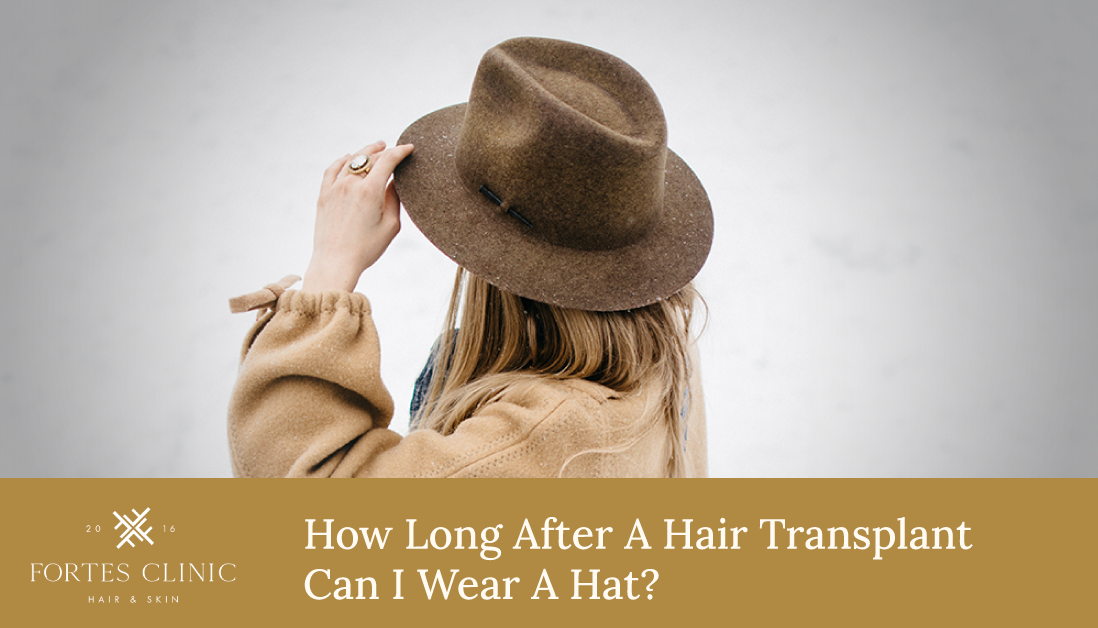Quick answer
Patients often ask, “How long after a hair transplant can I wear a hat?” Most people can use a very loose hat from days 5-7 if it does not touch or press on grafts. A more typical, comfortable hat is fine by days 10-14, once grafts have anchored and scabs have lifted. Healing speeds differ, so follow the plan you were given. For the whole journey, see the hair transplant recovery timeline.
Why timing matters
New grafts are delicate during the first week. Friction, pressure, sweat and heat under a hat can disturb healing skin. Waiting a few extra days reduces risk, lowers irritation, and makes wearing headwear feel normal again.
A sensible timeline (typical plan)
Your instructions take priority. This outline shows common practice.
- Days 0-4: No hat. Keep the recipient area untouched while grafts settle.
- Days 5-7: A very loose cap may be allowed for brief periods. It must sit clear of grafts and come off gently.
- Days 8-10: Comfort improves. Some can extend wear time if the scalp feels calm and scabs are lifting.
- Days 10-14: Grafts are usually secure. Most people can wear hats normally without risk.
- After day 14: Resume preferred styles. Build up time and snugness gradually.
If you are unsure how washing fits around hat use, this guide helps: when can I wash my hair normally after a hair transplant?
Picking the right hat
A good choice makes early wear easy.
- Fit: choose loose before snug. A cap that just rests on hair around the treated area is better than a tight beanie.
- Fabric: breathable cotton or light technical fabrics reduce heat and sweating.
- Brim and crown: a structured crown keeps material off the grafts; a soft, collapsible crown can rub.
- Cleanliness: Use a freshly washed hat to lower infection risk; rotate hats if you wear one daily.
- Removal: lift straight up; avoid dragging fabric across the recipient area.
What about helmets and protective headgear?
Helmets press on the scalp and trap heat. If possible, wait beyond two weeks. When you must wear one sooner, choose the loosest safe setting, pad any pressure points, keep sessions short, and cleanse the scalp gently afterwards. Reassess comfort the next day before repeating.
Sun, rain and cold
Shade is your friend early on. At two weeks, many people switch to normal sun protection habits. Use a hat outside for longer periods and reintroduce sunscreen when the skin feels calm and clear. Light rain is not harmful, but avoid getting stuck under a wet, tight hat that rubs.
Wearing a hat on the way home
Some patients bring a cap to the clinic. Whether you can wear it that day depends on your surgeon’s advice and how the hat sits. If it touches grafts, carry it instead.
Signs you should wait longer
Press pause and ask if you notice:
- Scalp that still looks very red or feels hot and sore.
- Thick, adherent scabs that have not lifted by day 12-14.
- Spots of bleeding after a short trial wear.
- Any warmth, pus or spreading irritation.
A short review keeps recovery on track and prevents minor issues from becoming bigger problems.
FUE vs FUT: Does the technique change timing?
The recipient area timeline is similar for both. The donor area differs behind the scenes:
- After FUE, dot sites usually feel comfortable in two weeks.
- After FUT, protect the linear scar from tension while it matures; keep clipper grades higher until cleared.
If you want a refresher on techniques, read: FUE hair transplant and FUT hair transplant.
Practical tips that make early hat use easier
- Choose structure: a cap with a firm front panel keeps fabric off healing skin.
- Mind sweat: if you get hot, take breaks and rinse the scalp gently later.
- Limit time at first: short outings are better than hours of continuous wear.
- Carry a spare: a clean backup avoids putting on a damp hat.
- Travel days: pack a mild shampoo and plan a careful cleanse after flights or long drives.
Common mistakes to avoid
- Tight beanies or caps that leave an imprint on the skin.
- Pulling a hat off against the hair grain.
- Wearing a dirty gym cap in week one.
- Power showers straight after taking a hat off in the first week.
- Long stretches in hot environments, while still in the early phase.
FAQs
How long after a hair transplant can I wear a hat safely?
Most people can use a very loose hat from days 5-7, and wear normal hats from days 10-14 once scabs have lifted.
Is a bucket hat better than a beanie?
Usually yes. A bucket hat or structured cap keeps fabric off grafts. Tight beanies rub and trap heat.
Can I wear a hat at work in week one?
If you must, choose the loosest option and limit time. Ask for tailored permission first.
Will a hat slow down healing?
Not if you wait until grafts are secure and keep the hat clean and loose.
Do I need medication to wear a hat sooner?
No. Time and gentle care matter most. Medication decisions should be made for hair maintenance, not hat timing.
What to expect next
By two weeks, hat use feels straightforward. The focus shifts to gentle washing, gradual return to exercise, and patience while the follicles cycle. If you want a check, send photos or arrange a chat via the contact page.
Summary
The practical answer to “how long after a hair transplant can I wear a hat” is about two weeks for normal wear, with a light, very loose option possible from days 5-7. Prioritise fit, fabric and cleanliness, build up time gradually, and pause if the scalp protests. A few careful choices give you cover without risking your result.



